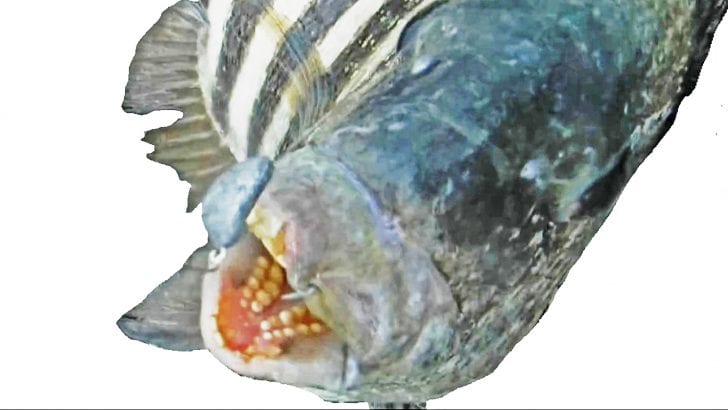Locals in the Lowcountry are usually accustomed to finding Sheepshead during our winter months because they seem to be more abundant.
It is definitely easier to find the larger Sheepshead during our winter months. As we move into spring here in the Lowcountry, the Sheepshead change their tactics.
They start to move into the shallows, in the flats or in shallow locations where they can enter grasslands and marshes during high tide.
They are looking for every crustacean they can find that’s on their diet, as the crustaceans become quite active when the weather and water start to warm.
You will also see large groups of Sheepshead moving together in the shallows between 10 or 11 can be seen at one time between sizes 10 to 18 inches.
If the water is clear enough and you look around some nearby structure in the flat, you may find a big female or male in the 23- to 25-inch category.
This is when fishing for Sheepshead can become fun, just by changing up some techniques while fishing for them this time of year.
I consider Sheepshead to be a great game fish
I consider Sheepshead to be a great game fish, not only tedious and sneaky in its feeding habits, but a great and powerful fighter.
To make the fight between yourself and the Sheepshead even sportier, I like to move to the ultra light category with my rod, reel and fishing line, which here in the Lowcountry is 8 pound test and under.
Instead of using a Carolina rig or a drop shot rig, I like to tie directly to a jig head and throw my bait as if I’m throwing an artificial.
But, not just any jig head, it is a Crab Stand up Jigg Head by Savage Gear. They were intended to be used with their artificial crabs, but these jig heads are perfect for live Fiddler Crabs.
If the Fiddler Crab is placed correctly on the jig head, the jig head will move through the water with the crab above it with its arms out.
If you have targeted a Sheepshead, the first thing you want to be careful of is not spooking him
As it falls to the bottom, the jig head will sit directly under the crab, leaving the crab in a defensive position that looks natural.
This technique is perfect for sight fishing for Sheepshead in the shallows.
If you have targeted a Sheepshead, the first thing you want to be careful of is not spooking him or them, if you have seen a group.
The second thing is to anticipate the direction they will move in. The third thing will be to cast your line away from the Sheepshead in the direction you anticipate they will move.
In doing so, you can avoid spooking them. After your jig with the live crab hits the water, allow the jig to fall with the crab and slowly pull it to the destination you want the jig and crab to rest.
As the Sheepshead approach, slowly twitch the jig head, catching the Sheepshead’s attention to the crab.
When twitching the jig head, if the water is clear enough, you will notice a small sediment cloud as you shake your jig head and crab.
To a Sheepshead, this looks like a crab trying to take cover. As the Sheepshead approaches, he will notice the crab in its defensive stance.
To a Sheepshead, this usually means battle on! Of course, the Sheepshead is usually the winner.
You will observe the Sheepshead move into sort of a headstand, and in most cases, turn sideways.
He will then dip down, and in one swift inhale, grab the crab, along with your jig head. There is no waiting at this point.
You must set the hook right away before the Sheepshead discards the jig head, and then the fight is on! If the Sheepshead is a large one, a challenging fight it will be.
The only other thing I would recommend is when fishing for Sheepshead with this light of tackle, it is important to look at all the structure around you, even before fighting a fish.
This will give you a heads up on what to avoid and how the fight will turn out, like whether you have to pull to the right or pull to the left, stand in a different position, force him to you, force him away from you, and so on.
Not all battling techniques always work. After all, a fish has a mind of its own. But, in most cases, if you have experience, or you’re just trying to gain experience, this technique with spring Sheepshead will sure give you experiences that will last a lifetime.
Like I always say, good luck out there and have fun fishing! To view some fishing adventures, go to my YouTube Channel “Fishing with Jiggin Jerry” or www.jigginjerry.net.
You may also enjoy reading Artificials Vs. Oyster Beds & Structures




